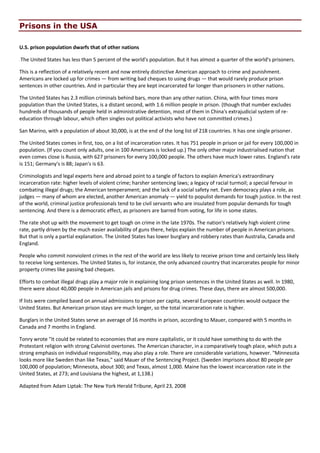
9 Prisons in the United States
- 1. Prisons in the USA U.S. prison population dwarfs that of other nations The United States has less than 5 percent of the world's population. But it has almost a quarter of the world's prisoners. This is a reflection of a relatively recent and now entirely distinctive American approach to crime and punishment. Americans are locked up for crimes — from writing bad cheques to using drugs — that would rarely produce prison sentences in other countries. And in particular they are kept incarcerated far longer than prisoners in other nations. The United States has 2.3 million criminals behind bars, more than any other nation. China, with four times more population than the United States, is a distant second, with 1.6 million people in prison. (though that number excludes hundreds of thousands of people held in administrative detention, most of them in China's extrajudicial system of reeducation through labour, which often singles out political activists who have not committed crimes.) San Marino, with a population of about 30,000, is at the end of the long list of 218 countries. It has one single prisoner. The United States comes in first, too, on a list of incarceration rates. It has 751 people in prison or jail for every 100,000 in population. (If you count only adults, one in 100 Americans is locked up.) The only other major industrialised nation that even comes close is Russia, with 627 prisoners for every 100,000 people. The others have much lower rates. England's rate is 151; Germany's is 88; Japan's is 63. Criminologists and legal experts here and abroad point to a tangle of factors to explain America's extraordinary incarceration rate: higher levels of violent crime; harsher sentencing laws; a legacy of racial turmoil; a special fervour in combating illegal drugs; the American temperament; and the lack of a social safety net. Even democracy plays a role, as judges — many of whom are elected, another American anomaly — yield to populist demands for tough justice. In the rest of the world, criminal justice professionals tend to be civil servants who are insulated from popular demands for tough sentencing. And there is a democratic effect, as prisoners are barred from voting, for life in some states. The rate shot up with the movement to get tough on crime in the late 1970s. The nation's relatively high violent crime rate, partly driven by the much easier availability of guns there, helps explain the number of people in American prisons. But that is only a partial explanation. The United States has lower burglary and robbery rates than Australia, Canada and England. People who commit nonviolent crimes in the rest of the world are less likely to receive prison time and certainly less likely to receive long sentences. The United States is, for instance, the only advanced country that incarcerates people for minor property crimes like passing bad cheques. Efforts to combat illegal drugs play a major role in explaining long prison sentences in the United States as well. In 1980, there were about 40,000 people in American jails and prisons for drug crimes. These days, there are almost 500,000. If lists were compiled based on annual admissions to prison per capita, several European countries would outpace the United States. But American prison stays are much longer, so the total incarceration rate is higher. Burglars in the United States serve an average of 16 months in prison, according to Mauer, compared with 5 months in Canada and 7 months in England. Tonry wrote "It could be related to economies that are more capitalistic, or it could have something to do with the Protestant religion with strong Calvinist overtones. The American character, in a comparatively tough place, which puts a strong emphasis on individual responsibility, may also play a role. There are considerable variations, however. "Minnesota looks more like Sweden than like Texas," said Mauer of the Sentencing Project. (Sweden imprisons about 80 people per 100,000 of population; Minnesota, about 300; and Texas, almost 1,000. Maine has the lowest incarceration rate in the United States, at 273; and Louisiana the highest, at 1,138.) Adapted from Adam Liptak: The New York Herald Tribune, April 23, 2008